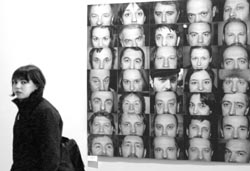A Time to Speak Out

An unprecedented action has taken place in Ukraine: for the first time the domestic artists openly opposed the Chechnya war. Finally, kitchen and corridors talks made it to the public level. Of course, one can pose a rather logical question, how timely is such pacifism against the background of other conflicts systematically discussed in the mass media? How ever, it is obvious that protests against any violence are always to the point, even if this violence is competently justified by global propaganda or, to the contrary, is thoroughly concealed to cover the crime.
An exhibition titled Invasion has recently opened at Kyiv’s Artist’s House. The project combines painting, photography, and sculpture. Presenting their works under the unifying concept of protest, a few dozen artists liberated themselves from a sore point of keeping silence in time when one has to speak out. It seems a little strange that only now, during the second Chechnya campaign (in fact, a true war), where tens of thousands are dying and hundreds of thousands are forced to become refugees, the artists finally made up their minds to say a resolute No. At first glance, it seems that nobody is forbidding them to protest. However, the specifics of the relations between Russia and Ukraine (officially Ichkeria-Chechnya is a part of the Russian Federation) and our country’s prevailing position have a strong effect on the possibility to say No when the country says, “This is none of our business,” shyly closing its eyes to the war. Compare this with the international human rights organizations, which expose human rights violations in Chechnya all the time. There are uncountable maimed and destroyed people’s fates behind this dry formula.
At the exhibition opening, the artists themselves and active public figures gave speeches. Thus, Professor Larysa Skoryk expressed her gratitude to the artists for their “efforts to revive the Ukrainian intelligentsia.” Prof. Skoryk remarked that Ukrainians, who themselves have a tragic history, should understand very well what “cleansing” is like. Skoryk was herself in Chechnya in 1996. This is how she underscored what she saw there: “This is not even a war, this is a total extermination of a nation. This is genocide!”
Artist Les Podervyansky, presenting his Soldier and the Witch (canvas, oil, 2003) at the exhibition, said in part, “I am pleased that we are not slaves but citizens who refuse to content themselves with the chewing gum of official propaganda. We also suffer from cultural occupation, this is why Chechnya is so close to us.”
The exhibition also displays a vivid “Without Motherland” series by renowned photo artist Oleksandr Hliadelov (camps in Ingushetia containing, according to the data of the Danish Council as of February 12, 2003, 93,383 Chechen refugees); Badri Gubianuri’s My Family diptych (first photograph dated by 1913, and second in the early twenty-first century when this same family was completely destroyed; eight desks of Matviy Vaisberh’s Judaic Desert; Temo Svireli’s impressive triptych Adamiani; Dedication to Chechnya by Petro Bevza (1998), and Variations in Black by Oleksandr Zhyvotkov.






